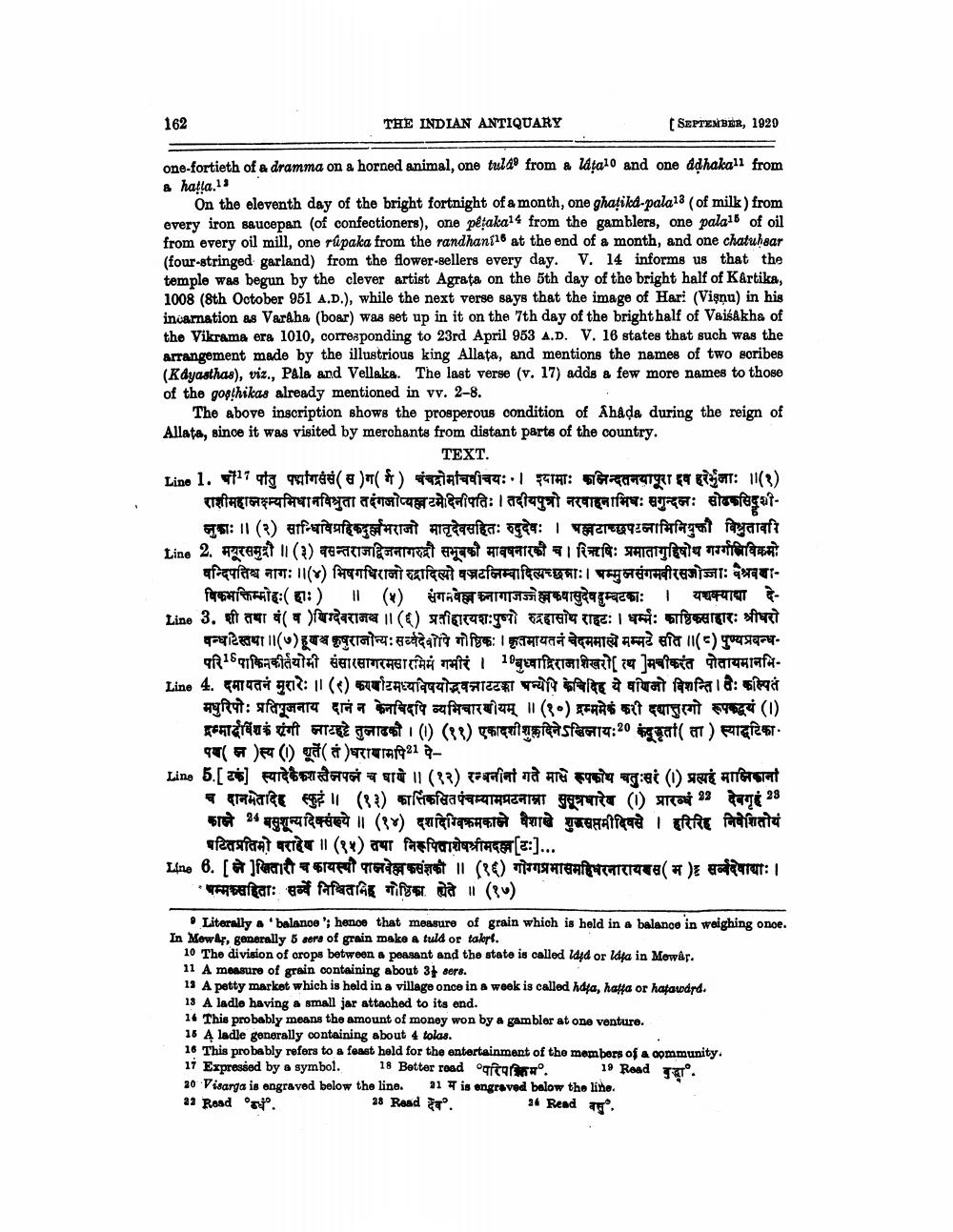________________
162
THE INDIAN ANTIQUARY
one-fortieth of a dramma on a horned animal, one tulas from a latal and one ddhakal from & ha!!a. 12
On the eleventh day of the bright fortnight of a month, one ghatika-pala13 (of milk) from every iron saucepan (of confectioners), one pêtaka14 from the gamblers, one pala15 of oil from every oil mill, one rûpaka from the randhani18 at the end of a month, and one chatuḥear (four-stringed garland) from the flower-sellers every day. V. 14 informs us that the temple was begun by the clever artist Agrata on the 5th day of the bright half of Kartika, 1008 (8th October 951 4. D.), while the next verse says that the image of Hari (Visnu) in his incarnation as Varaha (boar) was set up in it on the 7th day of the bright half of Vaisakha of the Vikrama era 1010, corresponding to 23rd April 953 A.D. V. 16 states that such was the arrangement made by the illustrious king Allata, and mentions the names of two scribes (Kayasthas), viz., Pala and Vellake. The last verse (v. 17) adds a few more names to those of the gosthikas already mentioned in vv. 2-8.
[ SEPTEMBER, 1920
The above inscription shows the prosperous condition of Ahâḍa during the reign of Allata, since it was visited by merchants from distant parts of the country.
TEXT.
Line 1.27 पोतु पद्मगसं सं ( स ) ग ( र्ग) चंचद्रोमाचवीचयः । श्यामाः कलिन्दतनयापुरा इव हरेर्भुजाः ॥ (१) राशीमहालक्ष्म्यभिधानविता गोप्य उमेदिनीपतिः। तदीयपुत्री नरवानामिचः गुन्दनः खोडकी
लुकाः ।। (२) सान्धिविग्रहिकदुर्लभराजो मातृदेवसहितः रुदुदेवः । अलटाच्छपटनामिनियुक्ती विश्रुतावरि Line 2. मयूरसमुद्री ॥ (३) वसन्तराज द्विजनागरुद्री सभूबकी मावषनारकी चरिऋषिः प्रमातागुहिषोथ गर्गनिविक्रमो वन्दिपतिध नागः । (४) भिषगविराजोखादिलो जनिम्वादिलच्छत्राः षम्मुखसंगी किम्बहाः) संगनल कनागाजज्जे कथासुदेव दुम्बटकाः ।
यचक्याचा देLine 3. शी तथा वं (व) विग्देवराजख || (६) प्रतीहारयशः पुष्पों रुद्रहासाथ राहटः । धर्म्मः काष्ठिकसाहारः श्रीधरो वन्ध टिस्तथा ।। (७) हूयश्च कृषुरानोन्यः सर्व्वदेवशषे गोष्ठिकः । कृतमायतनं वेदममात्ये मम्मटे सति । (६) पुण्यप्रबन्धपरिपाकिनकी यो संसारसागरमसारमेयं गभीरं बुध्वादिराजशेखरो र ]मीकरंत पोतायमानभिLive 4 दावनं सुरारेः । (२) मध्योद्भवनाका अन्य केचिदिह ये जो विशन्ति हैः कल्पितं
मधुरिपोः प्रतिपूजनाय दानं न केनचिदपि व्यभिचारणीयम् ॥ (१०) द्रम्ममेकं करी दवासुरगो रूपकद्वयं (1) द्रम्मादविंशकं शृंगी नाटहट्टे तुलाढकौ । (1) (११) एकादशी शुक्लदिने ऽविनायः 20 कंदूद्धृत ( ता ) स्याद्धरिका. (i)
(x) ॥
दानमेवदह
22
28
Line 5. [ ढकं ] स्यादेकैकश स्तेनपलं च धाये ॥ (१२) रन्जनीनां गते माझे रूपकोथ चतुःसरं (1) प्रत्यहं मानिकान (१३) कार्तिकलित पंचम्यामण्टनाना सुसूत्रभारेव (i) प्रारम्भं 23 देवगृहं 25 काने 24 मम्यदिवसरूपे || (१४) दशादेमिकाले वैशाख शुद्धसमीदिवसे । हरिरिह निवेशितो प्रतिम] बराच । (१५) तथा निरूपिताश्रीमदन [ट.]...]
Line 6. [जे]विवारी कायस्थी राजा कहको । (१६) गोग्गमासमहिधरनारायण ( स )
चम्मकसहिताः सर्वे निमोडिका हो । (१७)
• Literally a 'balance'; hence that measure of grain which is held in a balance in weighing once. In Mewar, generally 5 sers of grain make a tuld or takrt.
10 The division of arops between a peasant and the state is called laid or ldpa in Mewar.
11 A measure of grain containing about 3 sers.
13 A petty market which is held in a village once in a week is called hdja, hapa or hataward.
13 A ladle having a small jar attached to its end.
14 This probably means the amount of money won by a gambler at one venture.
15 A ladle generally containing about 4 tolas.
16 This probably refers to a feast held for the entertainment of the members of a community. 17 Expressed by a symbol. 18 Better road परिपक्रम. 18 Road बुद्धा".
21 म is engraved below the line. 28 Read देव 26 Read वसु
20 Visarga is engraved below the line. 23 Read
.




